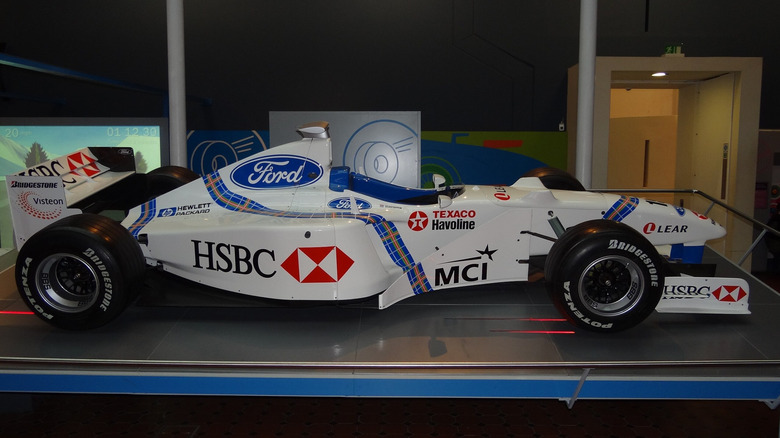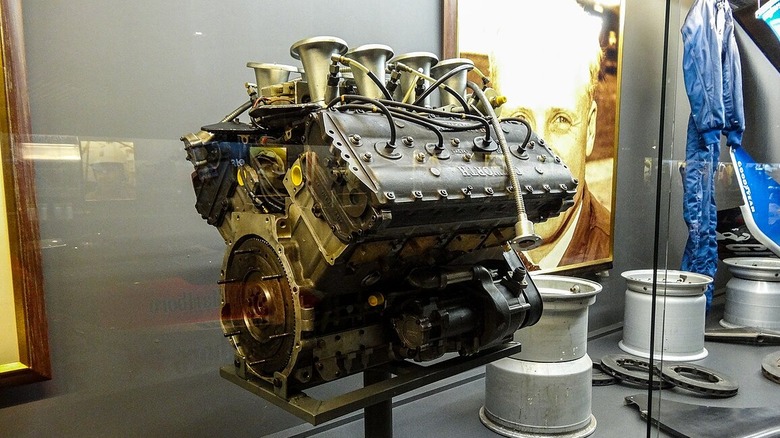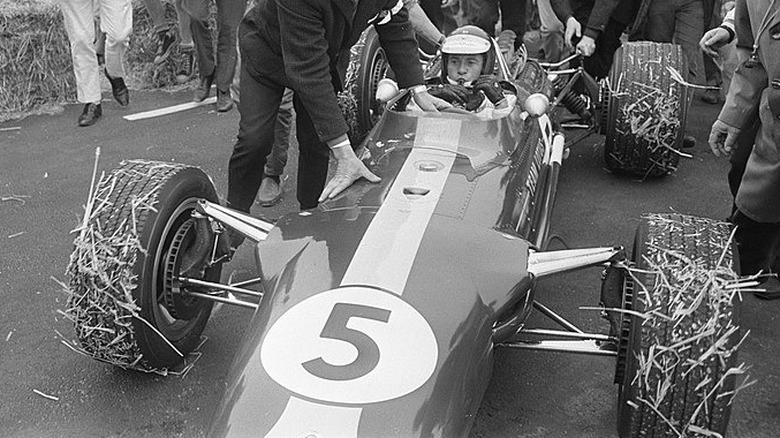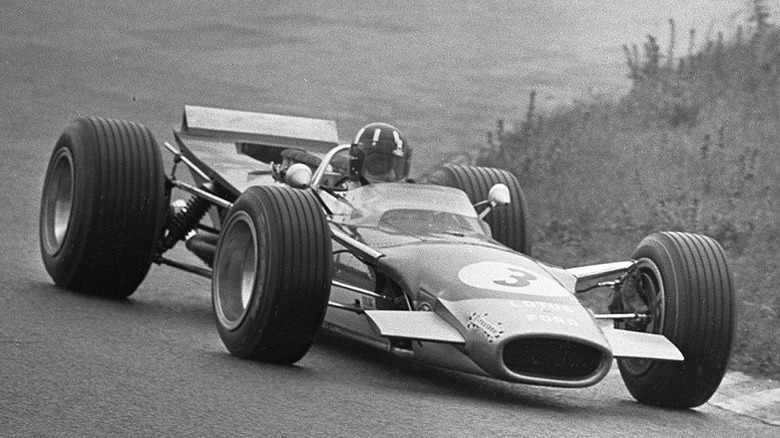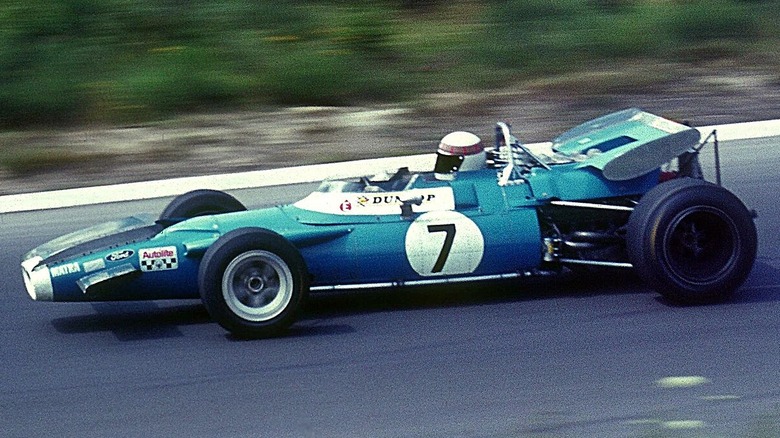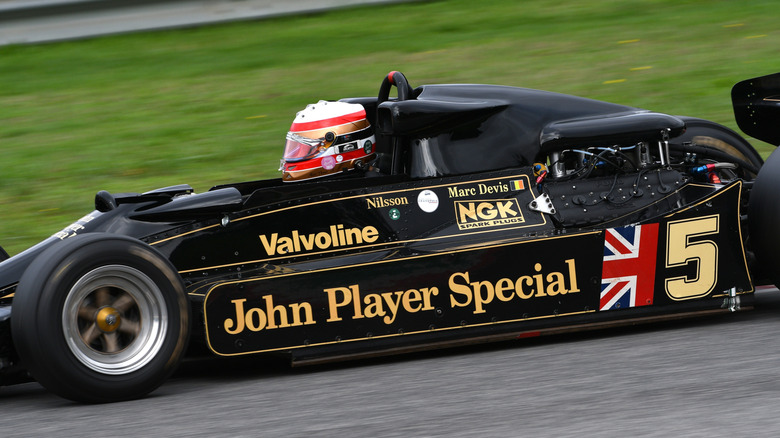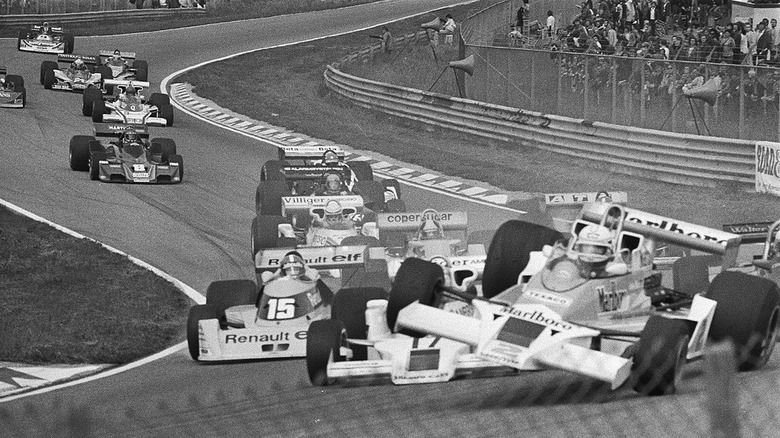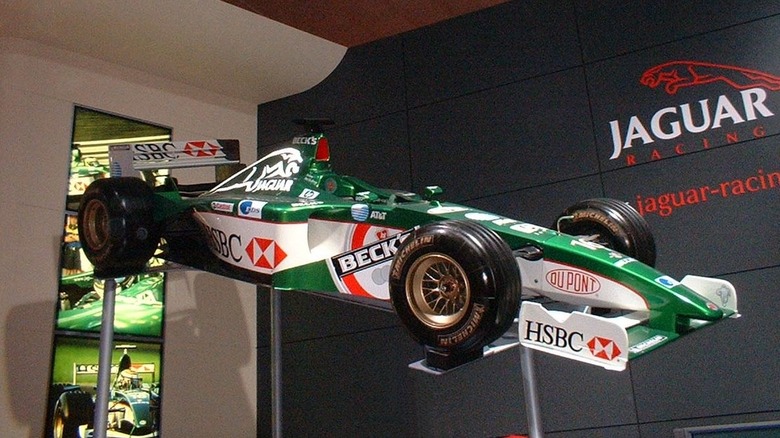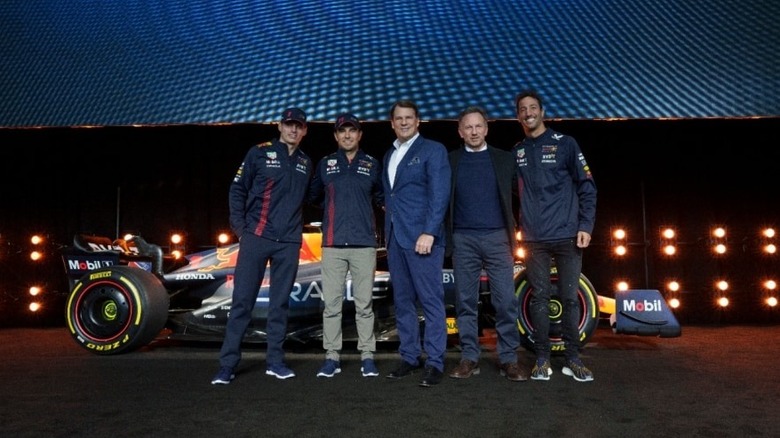Ford In F1: Key Moments In The Brand's Motorsport History
The Ford Motor Company is behind some of the most extraordinary feats in auto racing. From famously sweeping the podium at the 1966 24 Hours of Le Mans, as documented in 2019's "Ford vs Ferrari," to racking up over 700 wins in the NASCAR Cup Series, to reinventing open-wheel racing, the automaker enjoys a sterling pedigree at the racetrack.
Yet you won't find the blue oval amongst the teams in Netflix's hit "Drive to Survive." That's because the smash hit documentary series debuted in 2019 — 15 years after Ford bowed out of Formula 1 racing. Its last team raced under the Jaguar banner, which Ford owned at the time. After four uninspiring years in Jaguar green, Ford ended its 37 year F1 racing run. New fans of Formula 1 might not even know Ford once dominated the most sophisticated racing series in the world.
Early in 2023, Ford announced it would return to F1 for the 2026 season. New engine regulations call for sustainable fuel and low emissions as part of an initiative to reduce carbon emissions, a goal Ford shares for its road-going cars. Racetracks are testing grounds for technologies that ultimately make way to road cars, and Ford's commitment to Carbon Net Zero by 2030 has enticed it back into the ring.
In honor of Ford's impending return to Formula 1, let's examine the key moments in the brand's storied motorsport history.
[Featured image by Ben Sutherland via Wikimedia Commons | Cropped and scaled | CC BY-SA 2.0]
1965: Ford partners with Cosworth
Like the cars that inspired the legendary GT40 and Shelby Cobra, Ford's journey to Formula 1 started in England with Cosworth Engineering.
Founders Keith Duckworth and Mike Costin established Cosworth in London in 1958 to build a company focused on performance engineering. Within a few years, the organization began working with Ford's new 1,300cc and 1,500cc engines for Formula Junior. When Formula Junior met its demise in 1963, Cosworth pivoted to Formula 3 and then Formula 2, building engines for Lotus.
By 1965, Cosworth had garnered a reputation for success as an engine builder. With impending regulation changes, Lotus team boss Colin Chapman needed a new engine to keep up with new regulations. Chapman ultimately appealed to Ford for enough cash to put Cosworth on the case.
Ultimately, Ford invested a $280,000 infusion of cash to develop a pair of Cosworth engines. One would be a 1,600cc powerplant for F2 racing. The other would make history as one of the most dominant Formula 1 engines ever devised.
New regulations declared that for the 1966 season, builders could employ 3.0 liter naturally aspirated engines in F1 cars. It was by this blueprint that Cosworth developed a new V8 engine known as the Ford-Cosworth Double Four Valve V8, or DFV for short.
[Featured image by Falcon Photography via Wikimedia Commons | Cropped and scaled | CC BY-SA 2.0]
1967: Ford's first victory
Part of the DFV's success was its revolutionary design, which incorporated the engine into the car's chassis and supported the rear suspension. The 400 bhp V8 had the advantage of being lightweight, and while it looked complex, it was relatively easy to maintain and build.
Colin Chapman was responsible for affixing the engine to a competent race car, and the Lotus 49 chassis emerged from the shop. The new car proved tremendously light, tipping the scales at exactly the F1 minimum required weight of 1,102 pounds — 200 to 300 pounds under the competition.
The DFV debuted at the third race of the F1 season, the Dutch Grand Prix, on June 4, 1967. The engine's efficacy was immediately apparent. Lotus driver Graham Hill scored the pole position and led 10 laps before a breakdown forced his car's retirement. Teammate Jim Clark has better luck. After Hill left the track, Clark seized the lead and kept it, powering the DFV to Ford's first Formula 1 victory.
A new engine winning its first race is an enormous achievement. Hill's forced retirement proved to be a fluke failure of the valve train. The DFV was reliable and an absolute powerhouse. Though the Ferrari-powered Brabham team would take the championship, the DFV would accrue three more victories over the remaining eight races of the season.
[Featured image by Erich Koch via Wikimedia Commons | Cropped and scaled | CC BY-SA 3.0 NL]
1968: Ford's first championship
The DFV was an immediate and unmitigated success, and Ford wanted to use the opportunity effectively. The company promptly informed Lotus that it would no longer enjoy exclusive rights to the engine. Pricing it at £7,500 (about $210,000 in 2024), Ford offered it to other teams for the 1968 season. The move would prove wise for Ford.
Much hay is made of Ford's podium sweep at the 1966 24 Hours of LeMans, but the 1968 F1 season was nothing less than a Ford-engineered blowout unfolding over several months. Ford-powered cars won the first five races of the season before a Ferrari managed to secure a win, after which the DFV returned to form, sweeping Ford to the top spot for the rest of the season.
Matra and McLaren shared the glory, but the Lotus Ford took the championship. Tragically, Jim Clark died in an accident in April 1968, but Lotus pilot Graham Hill scored 48 points, securing himself the Driver's Championship. Lotus Ford won the Constructor's Trophy with 62 points. And if that wasn't enough, the McLaren and Matra Ford teams secured second and third place, respectively.
It was clear that Ford was in Formula 1, and its entry seemed like it could turn the entire racing world upside down. No one imagined the level of success the Ford team would ultimately achieve.
[Featured image by Joost Evers via Wikimedia Commons | Cropped and scaled | CC BY-SA 3.0 NL]
1969: The perfect season and beyond
Ford's running of the Formula 1 circuit throughout the 1970s may be one of the most incredible stretches of motorsport domination. Just a year after winning all but one race, Ford completed the perfect season by winning all eleven races of the 1969 F1 season.
Jackie Stewart, driving for Matra, claimed the driver's title with 63 points. The top four teams in the constructor standings, Matra, Brabham, Lotus, and McLaren, all harnessed the power of Ford engines. Fourth-place McLaren secured 38 constructor points, while the next-best Ferrari team lagged far behind with a mere seven.
Other teams joined the ranks of the Ford faithful. Ford went on to win the constructor's championship every year between 1968 and 1974, helping secure driver's championships for Graham Hill at Lotus, Jackie Stewart driving for Tyrell and Matra, Emerson Fittipaldi for McLaren and Lotus, and Jochen Rindt (who won posthumously after being killed during a practice session at the Italian Grand Prix) with Lotus.
Niki Lauda finally relieved Ford of its unbelievable winning streak by taking the driver's and constructor's titles in a factory Ferrari in 1975. James Hunt bested Lauda by a single point for the driver's title in a McLaren Ford in 1976, but Ferrari earned the constructor win over the Ford team. Could it be that Ford's incredible run in the first half of the 1970s would end as builders caught up with the excellence of the DFV?
[Featured image by Lothar Spurzem via Wikimedia Commons | Cropped and scaled | CC BY-SA 2.0 NL]
1977: Ground effect
Ford and Cosworth continued developing the DFV, but stiff competition came from Ferrari. Lauda had taken the 1975 title with a flat-12 Ferrari engine that proved it could more than keep up with the DFV, but one of the most monumental evolutions in Formula 1 would twist fate in Ford's favor for just a tad longer.
By 1977, the DFV was a decade old and seemed to be losing ground — until Colin Chapman and Lotus sparked a revolution. Chapman was a structural engineer by education and a former Royal Air Force pilot. He was looking for a way to improve Lotus' performance on the track when he struck on a theory: If a wing could lift an airplane off the ground, could an inverted wing keep a car glued to the road, improving traction?
The resulting Lotus 78 F1 car had a particular underside profile that created a ground effect, which Chapman and his team had discovered during exhaustive wind tunnel testing. The increased traction translated to faster cornering and braking, along with a flurry of last-gasp successes for Ford-powered cars.
The DFV's V8 profile allowed the space for ducts and tunnels that directed the air flowing under a car to create a ground effect. The flat-12 Ferrari engines left no such space. Ford's tried-and-true powerplant, with the advantage of ground effect, would help it win constructor's titles in 1979 and 1980.
1983: Ford falls behind
Ford's incredible run as an engine constructor had to end at some point. New regulations allowed for a 3.0-liter naturally aspirated engine or a 1.5-liter turbocharged engine. Renault introduced the first-ever turbo F1 car in 1977.
The new technology required more development, but by 1983, the naturally aspirated Ford won just three of the 15 races. The following year, the DFY engine, as the evolved DFV was known, was the only naturally aspirated engine in the field. Ford didn't win a single race. In 1986, regulations eliminated the 3.0-liter class entirely. Ford and Cosworth developed a 1.5-liter turbo in an unsuccessful attempt to keep up with the competition.
Natural aspiration returned with the introduction of a 3.5-liter class in 1987 in anticipation of the turbo ban that would take effect in 1989. Ford and Cosworth resurrected the DFY with a 575 hp variant. The engine catapulted Ford teams from the bottom of the barrel to mediocrity. Over the rest of the 1980s and into the early 1990s, the occasional win punctuated Ford's presence in the middle of the pack.
The last gasp of greatness for Ford's Formula 1 legend came in 1994 when Michael Schumacher achieved the driver's title. The Benetton Ford he piloted to the podium used a 3.5-liter Cosworth Ford V8, but Ford came in second for the constructor's title, losing by 15 points to a Williams powered by a Renault engine.
2000: Ford starts Jaguar Racing
In search of a third act in racing that would prove more successful than its second, Ford purchased the Stewart Grand Prix team in 2000. Despite being independent, the Stewart team had taken down some major competition in the previous few years, and with more resources and support it could potentially dominate the sport. Ford rechristened the team in Jaguar livery (it had purchased Jaguar in 1989) and had high hopes for a return to form.
The relationship with Cosworth continued. A 3.0-liter V10 engine dubbed the CR-2, which made 800 hp and revved to 20,000 rpm, held promise. Combining two legendary car builders seemed like just the remedy for Ford's recent racing woes. The Jaguar Ford team debuted at the Melbourne Grand Prix to massive hype. It was all over in less than five laps. A bad clutch retired one car, while an accident and a blown engine retired the other. It would be an omen.
Over the next four years, the Ford Jaguar team was mired in mediocrity, and Ford finally sold the team to Red Bull in 2005. The disastrous Jaguar era netted Ford a grand total of two podiums in five seasons.
[Featured image by CMP73 via Wikimedia Commons | Cropped and scaled | CC BY-SA 2.0]
2023: Don't call it a comeback
Ford's legendary run in its early Formula 1 career is virtually unparalleled. Even 20 years after leaving, Ford remains the third-winningest engine constructor in F1 history. Its partnership with Cosworth and the development of the DFV launched Ford into the stratosphere through the '70s and into the '80s. The rest of the century did not achieve nearly the same success, but few performances in the annals of motorsport could.
Ford announced its return for the 2026 season in early 2023. Just like the first time, the reason now is changing engine regulations. Formula 1 has decreed that teams must focus on sustainable fuel and electrical power, which closely aligns with Ford's corporate goals for its road-going cars.
From 2026 to 2030, Ford will return to F1 with the Oracle Red Bull and Scuderia AlphaTauri teams, sharing its expertise in building power units with battery and electric technology. Achieving revolutionary dominance is no mean feat, and the intense technological competition among Formula 1 teams, fueled by the sport's growth, keeps the outcome on a knife's edge.
There are compelling reasons to believe that Ford's return to the sport will be a game-changer, but the same optimism surrounded the Jaguar debacle. Only time will reveal the truth, but it's safe to say that the sight of the blue oval back in the paddock will be a welcome one.
